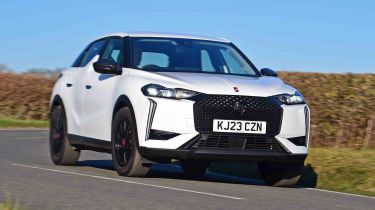DS 3 - MPG, CO2 and Running Costs
Running costs for the DS 3 should be good whether you go for petrol or electric power

The petrol DS 3 range isn’t as economical as the mild-hybrid Ford Puma, or the hybrid Nissan Juke and Toyota Yaris Cross. It also falls behind the plug-in hybrid Renault Captur, which makes a better small company car choice. However, there is an all-electric DS 3 E-Tense, which will be much more appealing to those paying Benefit-in-Kind (BiK) tax.
The base PureTech 100 is the most frugal petrol-powered DS 3, capable of returning up to 54.3mpg. The more powerful PureTech 130 with its eight-speed automatic gearbox isn’t as efficient, achieving up to 48.7mpg. However, rivals like the Juke and Yaris Cross have hybrid versions that can officially manage around 60mpg, and emit less than the DS 3. Emissions for the petrol-powered DS 3s aren’t class-leading either, ranging from 117g/km for the PureTech 100, and 130g/km for the PureTech 130.
Of course, if you’re concerned about tailpipe emissions or want to cut down on your running costs, then the all-electric DS 3 E-Tense is the model to go for. As part of the facelift for 2023, the small electric SUV now uses a 54kWh battery (up from 50kWh at launch), boosting its range from 193 miles to 250 miles on the WLTP combined cycle. All these figures are subject to varying wheel sizes and weight changes depending on which trim level you choose – stick with smaller wheels if economy and efficiency are primary concerns.
Recharging the 54kWh battery (51kWh useable) can be done at speeds of up to 100kW using a suitable rapid charger, and should take around 30 mins to top up from a 10 to 80 per cent state of charge. Most will try and take advantage of cheaper overnight electricity rates and utilise a 7.4kW wallbox charger at home. In a worst-case scenario, it’ll take 7.5 hours to fully charge a flat battery at that speed.
Until 2025, the zero-emission DS 3 E-Tense is exempt from road tax, as well as the London Congestion Charge.
Insurance groups
The DS 3 occupies insurance groups 15E to 21E for the petrol range, and groups 29A to 31A for the E-Tense electric model.
The lower end of that spectrum accounts for PureTech 100 models, with premiums increasing with engine power and pricier trims. For comparison, the Audi Q2 begins one group below and tops out (sporty SQ2 notwithstanding) in group 20 for a 35 TFSI petrol model. For a cheaper to insure electric rival, look towards the Renault Megane E-Tech, which starts in group 25, or the Peugeot E-2008, starting in group 26.
Our Car Tax Checker tool lets you check your tax status and renewal date in seconds. Check your VED car tax now...
Depreciation
Despite its left-field appeal, the DS 3 petrol range is likely to hold onto its value, according to our experts, similarly to the Audi Q2, ranging between 44 per cent for the entry-level Performance Line over three years and 36,000 miles, to 47 per cent for the top-of-the-range Opera trim. That’s a decent result, although it can’t match the Volkswagen T-Cross, which ranges from 50 to 54 per cent in terms of retained value over the same period.
The electric E-Tense doesn’t perform nearly as well, ranging from 37 to 40 per cent, while the similarly priced Kia Niro EV maintains a much healthier 55 to 57 per cent of its resale value over the same period.
To get an accurate valuation on a specific model check out our valuation tool...









